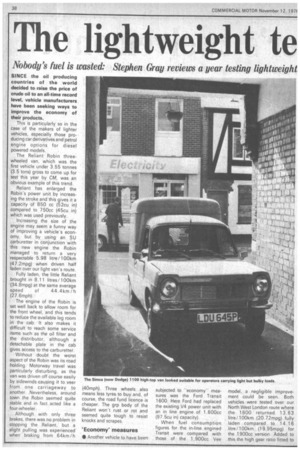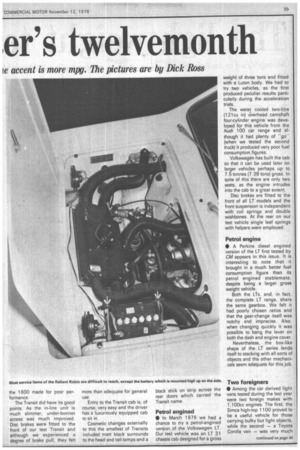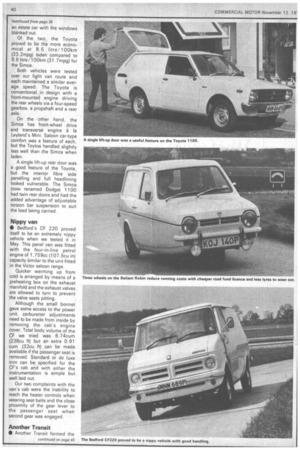The lightweight te er's twelvemonth
Page 40

Page 41

Page 42

Page 47

If you've noticed an error in this article please click here to report it so we can fix it.
Nobody's fuel is wasted: Stephen Gray reviews a year testing lightweight te accent is more mpg. The pictures are by Dick Ross
SINCE the oil producing countries of the world decided to raise the price of crude oil to an all-time record level, vehicle manufacturers. have been seeking ways to improve the economy of their products.
This is particularly so in the case of the makers of lighter vehicles, especially those producing car derivatives and petrol engine options for diesel powered models.
The Reliant Robin threewheeled van, which was the first vehicle under 3.55 tonnes (3.5 tons) gross to come up for test this year by CM, was an obvious example of this trend. Reliant has enlarged the Robin's power unit by increasing the stroke and this gives it a capacity of 850 cc (52cu in) compared to 750cc (45cu in) which was used previously. Increasing the size of the engine may seem a funny way of improving a vehicle's economy, but by using an SU carburetter in conjunction with this new engine the Robin managed to return a very respectable 5.98 litre/100km (47.2mpg) when driven half laden over our light van's route. Fully laden, the little Reliant brought in 8.11 litres/100km (34.8mpg) at the same average speed of 44 4km /h (27.6mph).
The engine of the Robin is set well back to allow room for the front wheel, and this tends to reduce the available leg room in the cab. It also makes it difficult to reach some service items such as the oil filter and the distributor, although a detachable plate in the cab gives access to the carburetter.
Without doubt the worst aspect of the Robin was its road holding. Motorway travel was particularly disturbing, as the van was driven off course easily by sidewinds causing it to veer from one carriageway to another. Nevertheless, around town the Robin seemed quite stable and in fact acted like a .four-wheeler.
Although with only three brakes, there was no problem in stopping the Reliant, but a slight pulling was experienced' when braking from 64km / h (40mph). Three wheels also means less tyres to buy and, of course, the road fund licence is cheaper. The grp body of the Reliant won't rust or rot and seemed quite tough to resist knocks and scrapes.
'Economy measures
• Another vehicle to have been
subjected to "economymeasures was the Ford Transit 1600. Here Ford had replaced the existing V4 power unit with an in line engine of 1,600cc (97.5cu in) capacity).
When fuel consumption figures for the in-line engined Transit were compared with those of the 1,900cc Vee model, a negligible improvement could be seen. Both vehicles were tested over our North West London route where the 1600 returned 13.63 litre/100km (20.72mpg) fully laden compared to 14.16. litre/100km (19.95mpg) for the 1900cc version Added to this the high gear ratio fitted to the 1600 made for poor performance.
The Transit did have its good points. As the in-line unit is much slimmer, under-bonnet access was much improved. Disc brakes were fitted to the front of our test Transit and although we experienced a degree of brake pull, they felt more than adequate for general use Entry to the Transit cab is, of course, very easy and the driver has a luxuriously equipped cab to sit in.
Cosmetic changes externally to this the smallest of Transits included matt black surrounds to the head and tail-lamps and a black stick on strip across the rear doors which carried the Transit name
Petrol engined
• In March 1976 we had a chance to try a petrol-engined version of the Volkswagen LT. Our test vehicle was an LT 31 chassis cab designed for a gross weight of three tons and fitted with a Luton body. We had to try two vehicles, as the first produced peculiar results particularly during the acceleration trials.
The water cooled two-litre (121cu in) overhead camshaft four-cylinder engine was developed for this vehicle from the Audi 100 car range and although it had plenty of "go" (when we tested the second truck) it produced very poor fuel consumption figures.
Volkswagen has built the cab so that it can be used later on larger vehicles perhaps up to 7.5 tonnes (7.38 tons) gross. In spite of this there are only two seats, as the engine intrudes into the cab to a great extent.
Disc brakes are fitted to the front of all LT models and the front suspension is independent with coil springs and double wishbones. At the rear on our test vehicle single leaf springs with helpers were employed.
Petrol engine • A Perkins diesel engined version of the LT first tested by CM appears in this issue. It is interesting to note that it brought in a much better fuel consumption figure than its petrol engined stablemate, despite being a larger gross weight vehicle.
Both the LTs, and, in fact, the complete LT range, share the same gearbox. We felt it had poorly chosen ratios and that the gear-change itself was notchy and imprecise. Also, when changing quickly it was possible to bang the lever on both the dash and engine cover.
Nevertheless, the box-like shape of the LT series lends itself to stacking with all sorts of objects and the other mechanicals seem adequate for this job.
Two foreigners
• Among the car derived light vans tested during the last year were two foreign makes with 1,100cc engines. The first, the Simca high-top 1100 proved to be a useful vehicle for those carrying bulky but light objects, while the second — a Toyota Corolla van — was very much an estate car with the windows blanked out.
Of the two, the Toyota proved to be the more economical at 8.5 litre/100km (33.2mpg) laden compared to 8.9 litre/100km (31.7mpg) for the Simca.
Both vehicles were tested over our light van route and each maintained a similar average speed. The Toyota is conventional in design with a front-mounted engine driving the rear wheels via a four-speed gearbox, a propshaft and a rear axle.
On the other hand, the Simca has front-wheel drive and transverse engine A la Leyland's Mini. Saloon car-type comfort was a feature of each, but the Toytoa handled slightly less well than the Simca when laden.
A single lift-up rear door was a good feature of the Toyota, but the interior fibre side panelling and full headlining looked vulnerable. The Simca (now renamed Dodge) 1100 had twin rear doors and had the added advantage of adjustable torsion bar suspension to suit the load being carried.
Nippy van
• Bedford's CF 220 proved itself to be an extremely nippy vehicle when we tested it in May. This panel van was fitted with the four-in-line petrol engine of 1,759cc (107.5cu in) capacity similar to the unit fitted in the Victor saloon range. Quicker warming up from
cold is arranged by means of a Three wheels on the Reliant Robin reduce running costs with cheaper road fund licence and less tyres to wear out. preheating box on the exhaust manifold and the exhaust valves are allowed to turn to prevent the valve seats pitting.
Although the small bonnet gave some access to the power unit, carburetter adjustments need to be made from inside by removing the cab's engine cover. Total body volume of the CF we tried was 6.74cum (238cu ft) but an extra 0.91 cum (32cu ft) can be made available if the passenger seat is removed. Standard or de luxe trim can be specified for the CF's cab and with either the instrumentation is simple but. well laid out.
Our two complaints with the van's cab were the inability to reach the heater controls when wearing seat belts and the close proximity of the gear lever to the passenger seat when second gear was engaged.
Another Transit
• Another Transit formed the light vehicle for test during September. This time it was the largest of that marque, the 190, which had been just launched. Designed to come under 0 licensing requirements with a gross weight of 3.51 tonnes ,(3.5 tons) it offered a useful payload advantage over the existing 175 This extra payload amounts to 140kg (309th) on the diesel model we tried. The Transit for test was fitted with a BradeLeigh lightweight dropside body which further improved its carrying capacity. Over our Midland circuit the truck returned an overall fuel con sumption of 11 .6 litre/100km (24.3mpg) at the high average speed 64.3km/h (40mph).
The Transit 190 is the largest model in the range and is fitted with ventilated disc front brakes and a vacuum servo. A cold start device aids easy starting of the 2.4-litre (144cu in) "York" diesel which is manufactured by Ford itself. Although the Transit range has been around for over 10 years there seems to be quite a lot of life left in the re-vamped models.
• All the heavier vehicles tested by CM during the year will be reviewed on November 26.












































































































































